
Top 8 Kanban Alternatives in 2025
Explore the 8 best Kanban alternatives in 2025. This listicle compares top project management tools, helping you find the perfect fit for your team.
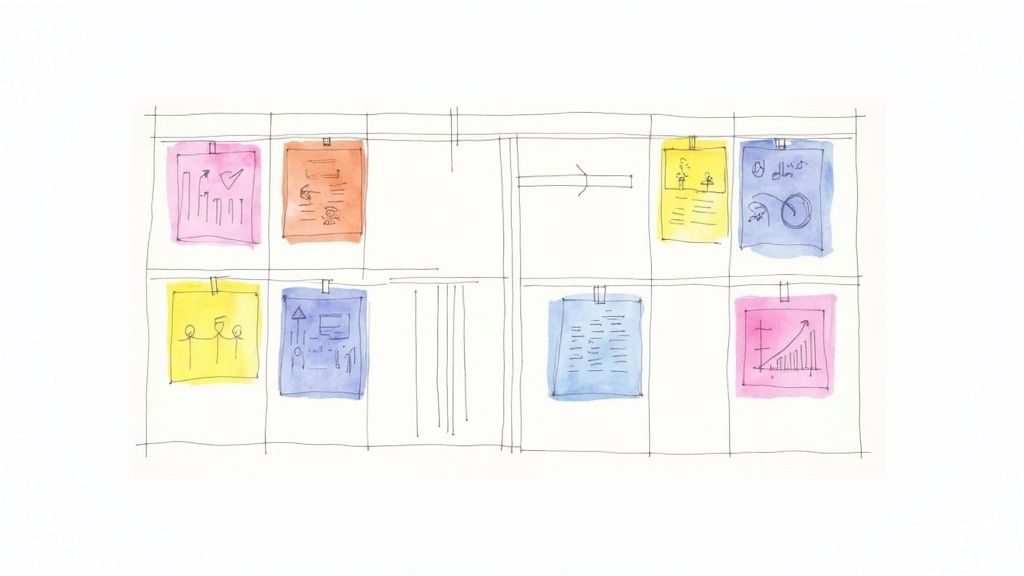
Beyond Kanban: Exploring New Horizons in Project Management
Need a fresh approach to project management? Kanban isn't always the perfect solution. This listicle presents eight powerful kanban alternatives designed for various team structures and workflows. Discover tools like Tooling Studio, Trello, Asana, Monday.com, ClickUp, Notion, Airtable, and Linear. Find the perfect fit for your team, whether you need Google Workspace integration, a built-in CRM, or a simple task management solution. Streamline your projects and boost productivity in 2025 with the right kanban alternative.
1. Tooling Studio
If you're a Google Workspace user seeking a powerful yet lightweight Kanban alternative, Tooling Studio offers a compelling solution. Its flagship product, Kanban Tasks, eliminates the need to juggle multiple apps by bringing a visual Kanban board directly into Gmail and Google Tasks. This seamless integration transforms your Google environment into a centralized task hub, streamlining workflows for individuals and teams alike. Imagine managing your sales pipeline, project tasks, or even your personal to-do list, all within the familiar interface of Gmail. This is the power and convenience Tooling Studio brings to the table.
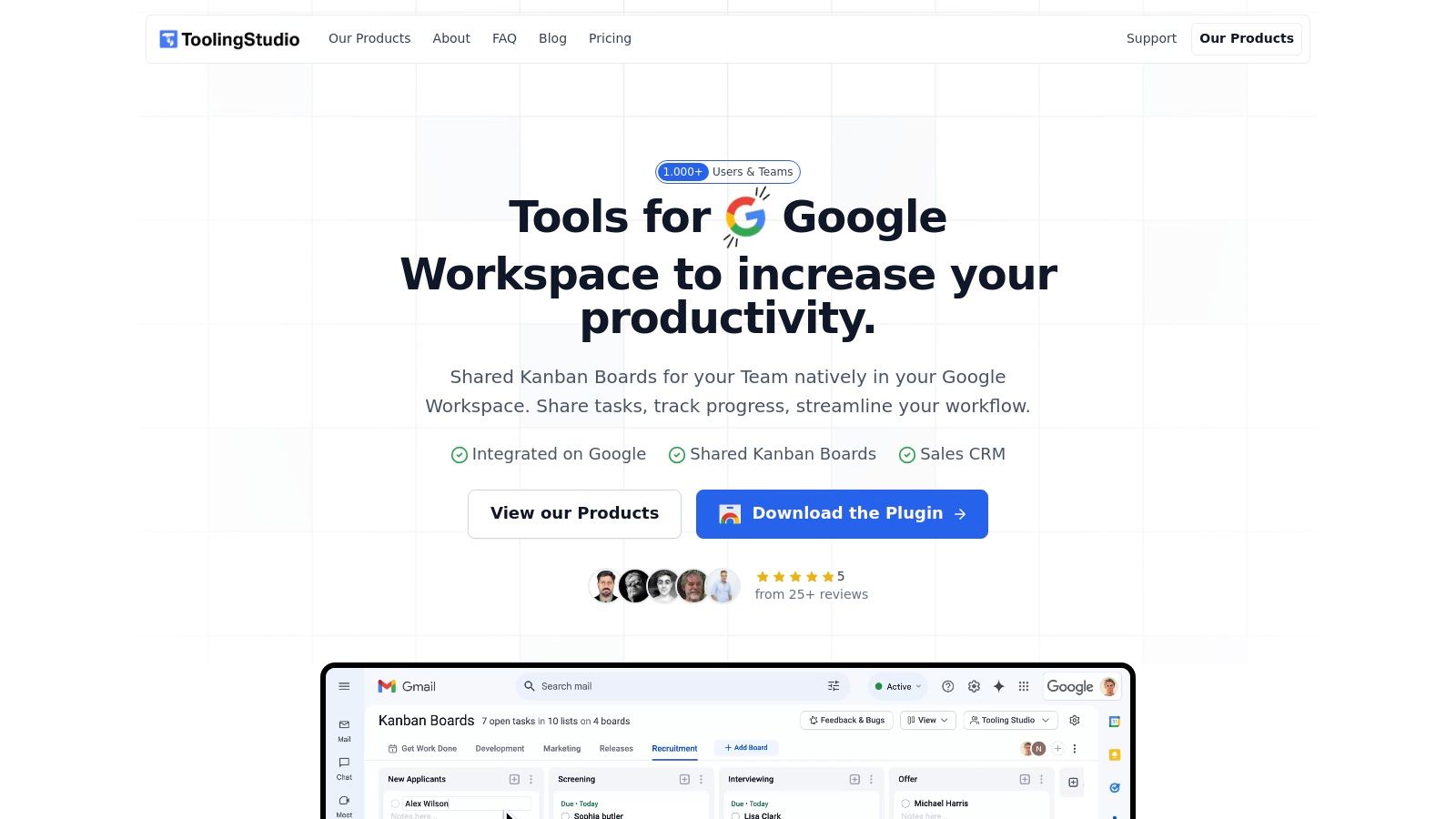
For project managers, the intuitive drag-and-drop interface of the Kanban board simplifies task assignments, progress tracking, and team collaboration. Sales representatives can manage leads and deals directly within Gmail, eliminating the need to switch to a separate CRM. SMBs and freelancers benefit from a centralized platform for managing all their tasks, while Google Workspace administrators appreciate the enhanced productivity and streamlined workflows it provides. Learn more about Tooling Studio to see how it can boost your team's productivity.
Tooling Studio goes beyond basic Kanban functionality with features like shared boards for real-time collaboration, comments for providing context and feedback, tags for organizing tasks, and the ability to add attachments directly to cards. A forthcoming Sales CRM extension further integrates with Google Contacts, promising a unified platform for managing customer interactions, leads, and deals, all within Google Workspace. The Kanban Tasks extension is currently free to install from the Chrome Web Store, with premium features and products planned for the future.
Pros:
- Seamless, native integration with Google Workspace: Manage tasks and sales directly within Gmail, Google Tasks, and soon, Google Contacts.
- Intuitive drag-and-drop Kanban boards: Visualize workflows, track progress, and collaborate in real-time.
- Lightweight Chrome extensions: Minimize app-switching and maintain focus within your Google environment.
- Clean, intuitive design: Easy to learn and use, praised by over 1,000 users.
- Continuous development: Regular updates and new features based on user feedback.
Cons:
- Chrome dependency: Currently only officially supports Google Chrome.
- Sales CRM in beta: Some CRM features are still under development and may be limited.
Tooling Studio stands out as a kanban alternative specifically designed for Google Workspace users. Its deep integration, intuitive interface, and focus on streamlined workflows make it a valuable tool for individuals and teams seeking to boost productivity without leaving their familiar Google environment. While the Chrome-only support might be a limitation for some, the promise of continuous development and upcoming features, like the integrated Sales CRM, positions Tooling Studio as a strong contender in the Kanban space, especially for those heavily reliant on Google Workspace. Visit the Tooling Studio website to learn more and get started.
2. Trello
Trello stands out as a highly visual and flexible kanban alternative, utilizing boards, lists, and cards to represent projects, tasks, and their respective stages. While not strictly adhering to the Kanban methodology, its adaptable nature allows teams to easily implement Kanban-style workflows for project management. Its intuitive drag-and-drop interface simplifies task organization and prioritization, making it a popular choice for teams of all sizes, from small businesses to enterprise-level organizations. Trello's strength lies in its simplicity and ease of use, allowing teams to quickly get up and running with minimal training. This makes it particularly appealing for those seeking a straightforward yet effective way to manage their work visually.
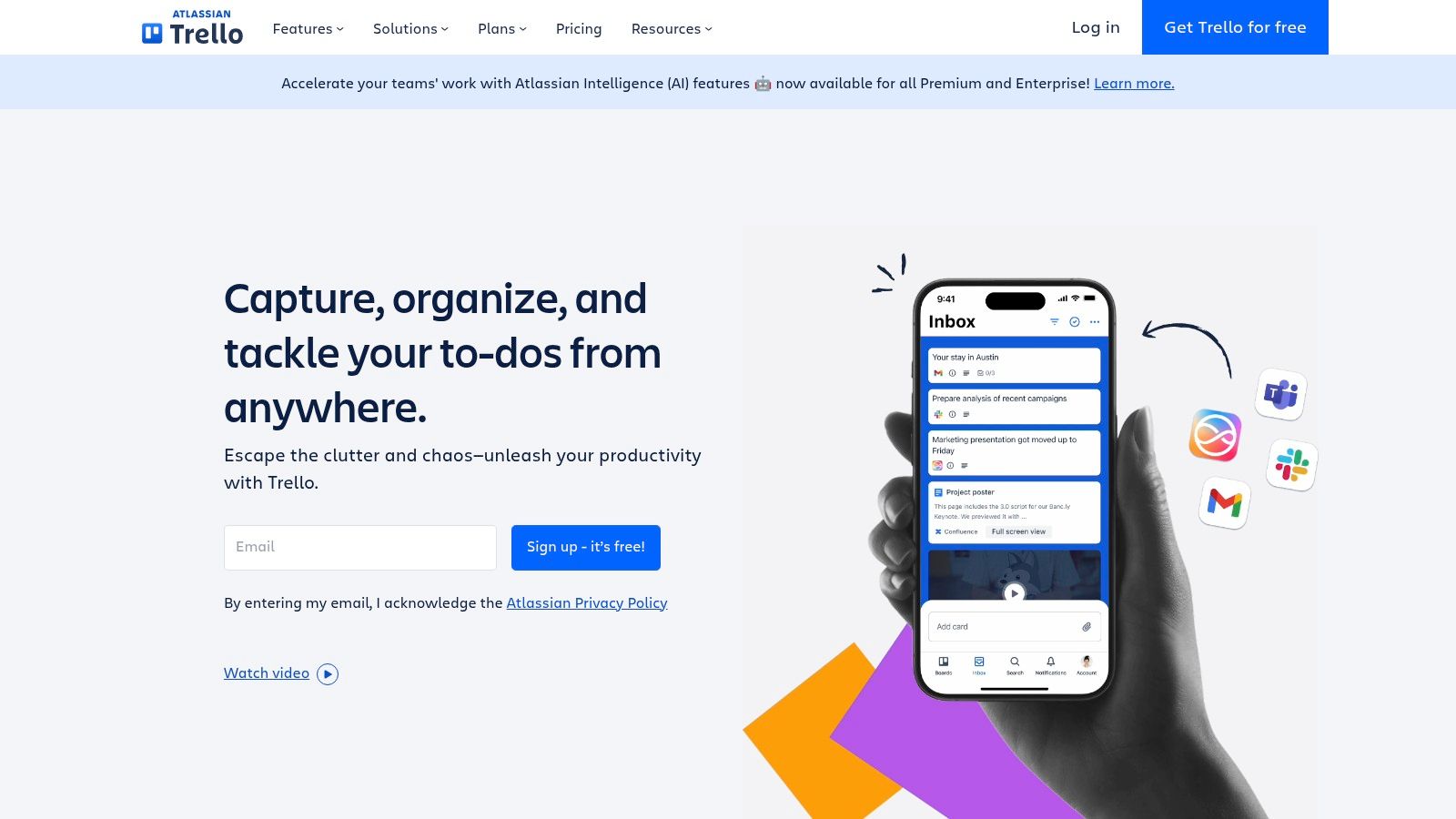
For project managers and team leads using Google Workspace, Trello offers seamless integration with various Google services, enhancing productivity and streamlining workflows. Small and medium-sized businesses will appreciate Trello's free tier, which provides ample functionality for basic project management. Sales teams can leverage Trello to manage their sales pipeline visually, tracking deals through different stages. Even individual professionals and freelancers can benefit from Trello's intuitive task management capabilities, organizing their to-dos and projects efficiently. Google Workspace administrators can easily deploy and manage Trello across their organization, further boosting team collaboration and productivity.
Trello's features extend beyond basic Kanban boards. Customizable boards allow teams to tailor their workflows. Cards can contain checklists, attachments, due dates, and discussions, providing a centralized hub for all task-related information. Power-Ups further enhance Trello's functionality by integrating with third-party tools like Slack, Google Drive, and Jira, creating a connected ecosystem for your team. Automation capabilities with Butler allow teams to automate repetitive actions, saving time and increasing efficiency. Mobile apps for iOS and Android provide access to projects and tasks on the go, facilitating real-time collaboration and updates across all devices.
Pricing: Trello offers a free plan, a Standard plan at $5/user/month (billed annually), a Premium plan at $10/user/month (billed annually), and an Enterprise plan (contact sales for pricing).
Technical Requirements: Trello is a web-based application accessible through any modern browser. Mobile apps are available for iOS and Android devices.
Compared to dedicated Kanban tools, Trello might lack some advanced features for complex dependency management. Learn more about Trello to understand how it compares to specific Kanban-focused applications.
Implementation Tip: Start with a simple board and a few lists to represent your workflow stages. Gradually add complexity as needed, utilizing Power-Ups and automation to streamline your processes. Experiment with different board layouts and card features to find what works best for your team.
Pros:
- Extremely user-friendly interface with virtually no learning curve
- Free tier is robust enough for small teams and personal use
- Highly visual approach to task management
- Extensive third-party integrations through Power-Ups
Cons:
- Limited reporting and analytics capabilities in the basic version
- Can become cluttered when managing complex projects or multiple teams
- Advanced features require paid plans
- Not ideal for complex dependency management
Website: https://trello.com
Trello earns its place on this list as a versatile and user-friendly kanban alternative, particularly suitable for teams seeking a visual and collaborative project management solution without the steep learning curve of more specialized Kanban tools. Its flexibility, integrations, and affordability make it a compelling option for a broad range of users.
3. Asana
Asana is a robust work management platform that goes beyond the functionalities of a simple Kanban board, making it a powerful Kanban alternative for teams seeking more comprehensive project management capabilities. While it incorporates Kanban-style board views, Asana's strength lies in its flexibility. It offers multiple project views including lists, timelines, calendars, and Gantt charts, catering to diverse project management styles and team preferences. This makes it ideal for managing complex projects that require more than just a simple Kanban workflow.
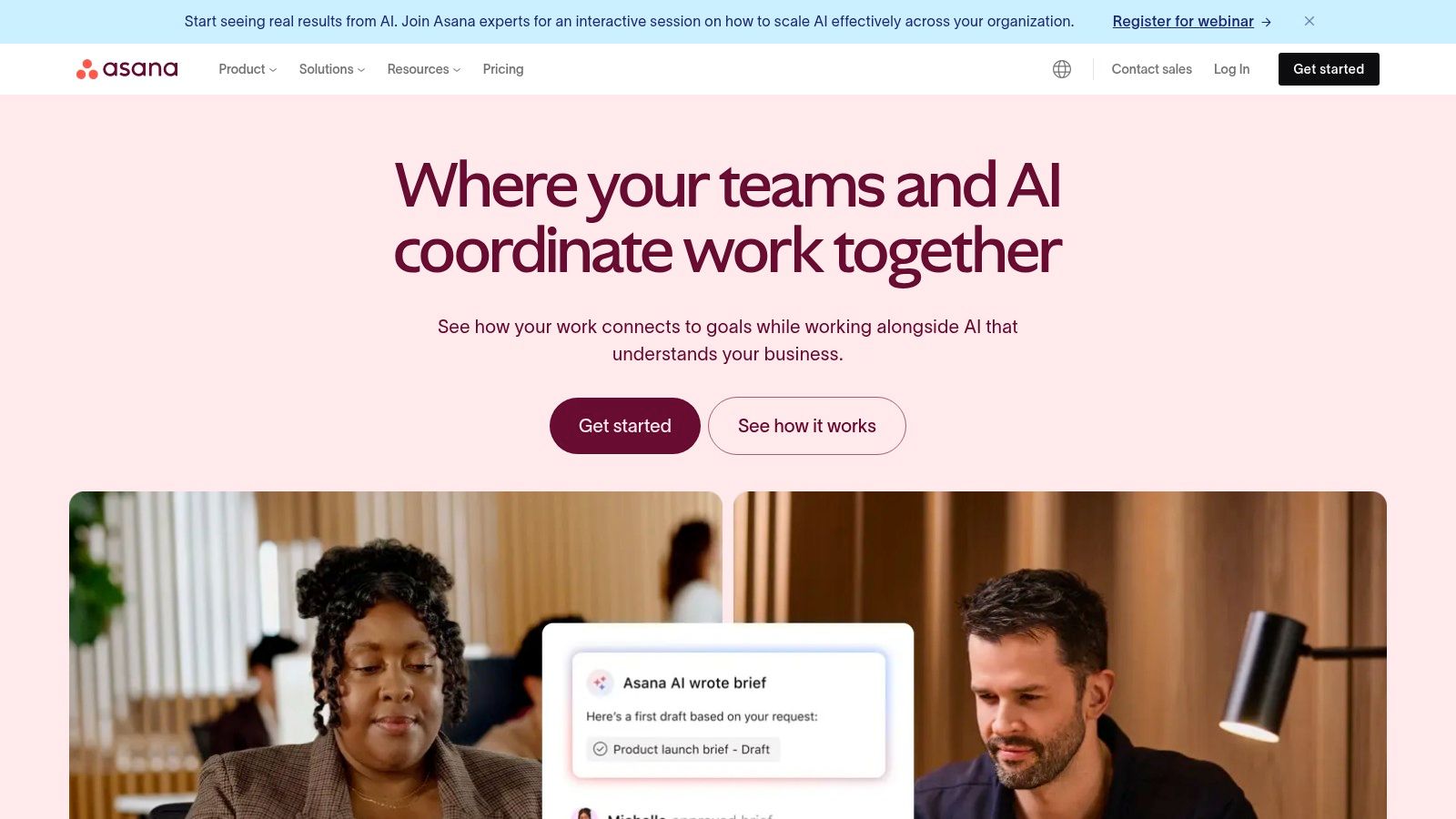
For example, a marketing team could use the Kanban board view to manage their content creation workflow, while simultaneously using the timeline view to track campaign milestones and deadlines. Similarly, a software development team could leverage Asana's list view for daily task management and the Gantt chart view to visualize project dependencies and track overall progress. This versatility is a key differentiator, setting Asana apart from pure Kanban tools and providing a central hub for all project-related activities.
Asana boasts features like customizable workflows with rules, forms, and approvals, allowing teams to automate repetitive tasks and streamline processes. Goal tracking connects daily work to broader business objectives, ensuring alignment and focus. The workload view helps manage team capacity, preventing burnout by providing visibility into individual workloads. Advanced reporting and status updates offer valuable insights into project performance, facilitating data-driven decision-making.
Pros:
- Highly versatile: Multiple view options cater to different preferences and project needs, making it a true Kanban alternative.
- Robust task management: Dependencies, subtasks, and custom fields enable granular task breakdown and management.
- Strong team collaboration: @Mentions and comments facilitate seamless communication and feedback loops.
- Excellent for cross-functional project coordination: Asana's comprehensive features support complex projects involving multiple teams.
Cons:
- Steeper learning curve: The extensive feature set can be overwhelming for new users or small teams.
- Can be overwhelming: The sheer number of features can be overkill for simpler projects.
- Free version limitations: The free plan is restricted to basic features and a limited number of team members (15).
- Cost: At the enterprise level, Asana can be more expensive than some other Kanban alternatives.
Pricing: Asana offers a free plan, as well as paid plans starting at $10.99 per user per month.
Technical Requirements: Asana is a cloud-based platform accessible through any web browser. Mobile apps are also available for iOS and Android devices.
Implementation Tips:
- Start with a small project to familiarize yourself with Asana's features.
- Utilize Asana's templates to quickly set up projects based on common use cases.
- Customize workflows and automate tasks using rules and forms.
- Regularly review the workload view to ensure balanced team capacity.
Asana's robust features and versatile project views make it an excellent Kanban alternative for teams seeking a comprehensive work management platform. While it may have a steeper learning curve, its ability to adapt to various project management methodologies and offer advanced functionalities justifies its place on this list. If you’re looking for a tool that can handle both simple and complex projects with ease, Asana is definitely worth considering. Visit their website at https://asana.com to learn more.
4. Monday.com: A Vibrant Kanban Alternative
If you're looking for a kanban alternative that offers robust customization and a visually engaging experience, Monday.com might be the perfect fit. More than just a simple Kanban board, Monday.com is a Work Operating System (Work OS) that empowers teams to build custom workflows, collaborate effectively, and manage projects with ease. Its colorful and intuitive interface makes project management less daunting and more engaging for team members. Unlike traditional Kanban, Monday.com's flexibility allows you to tailor your boards with various column types, automations, and integrations, moving beyond the limitations of simple card movement.
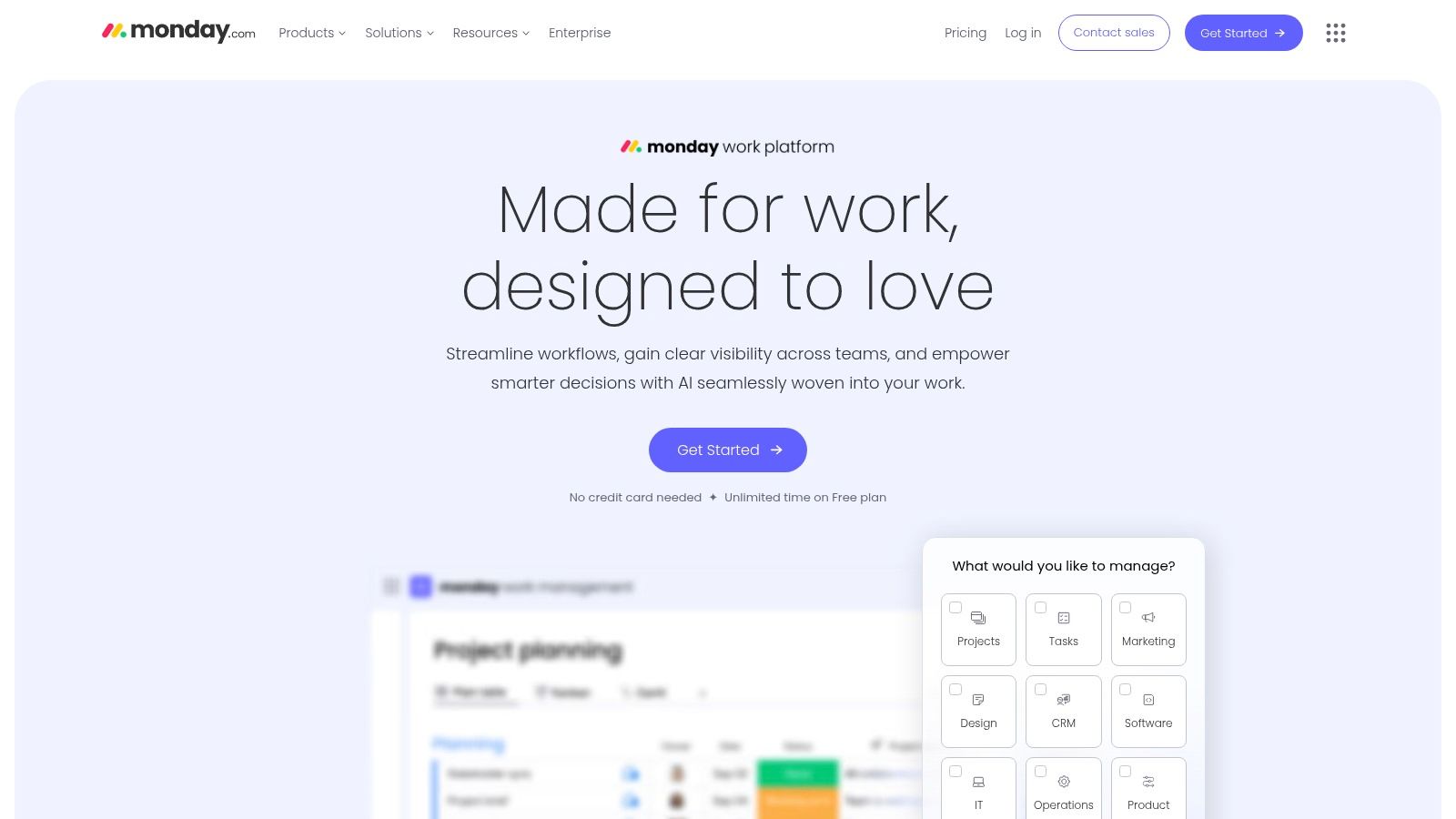
This platform is particularly well-suited for teams seeking a highly visual and adaptable project management tool. For example, marketing teams can use Monday.com to manage content calendars, track campaign progress, and visualize social media schedules. Software development teams can leverage it for sprint planning, bug tracking, and release management, while sales teams can benefit from its CRM capabilities to manage leads, track deals, and visualize sales pipelines. The versatility of Monday.com makes it a powerful kanban alternative for various project types and team sizes.
Monday.com shines with its 30+ column types, allowing for diverse data visualization, from simple text and numbers to progress trackers, time tracking, and even location mapping. Multiple views, including Kanban, timeline, calendar, map, form, and chart views, offer different perspectives on your project data, catering to various planning and reporting needs. Furthermore, its automation capabilities eliminate repetitive tasks and reduce human error, streamlining workflows and boosting productivity. For a high-level overview, the dashboard and reporting features provide valuable insights into project progress and performance. Getting started is made easier with 200+ ready-made templates catering to diverse use cases, giving you a head start in setting up your workflows.
Pros:
- Highly Visual and Engaging: The colorful interface promotes team engagement and makes project management more enjoyable.
- Exceptional Customization: Tailor workflows to your exact needs with numerous column types and views.
- Robust Integrations: Connect with 40+ popular tools to streamline your workflow.
- Scalability: Suitable for small teams to large enterprises.
Cons:
- Pricing: Can become expensive as your team grows.
- Limited Free Tier: Fewer features in the free version compared to some competitors.
- Initial Setup Time: Requires some investment to customize properly.
- Learning Curve: Some users find it initially challenging to master.
Pricing: Monday.com offers a free plan for basic individual use. Paid plans start from approximately $8 per seat per month and scale upwards based on features and user count.
Technical Requirements: Monday.com is a cloud-based platform accessible through any modern web browser. Mobile apps are also available for iOS and Android devices.
Implementation Tip: Start with a pre-built template that closely aligns with your needs. This will significantly reduce the initial setup time and allow you to familiarize yourself with the platform's features. Gradually customize the template and explore integrations to maximize the benefits of Monday.com. Investing time in proper setup and training will ensure a smooth transition and successful implementation.
5. ClickUp
If you're looking for a robust kanban alternative that goes beyond simple task management, ClickUp is a compelling option. It's designed as an all-in-one productivity platform, aiming to consolidate various work tools into a single, cohesive solution. Instead of being limited to just Kanban boards, ClickUp offers over 15 different views, allowing you to visualize and manage your work in the way that best suits your needs and projects. This flexibility makes it suitable for diverse teams and workflows, from software development and marketing to sales and project management.
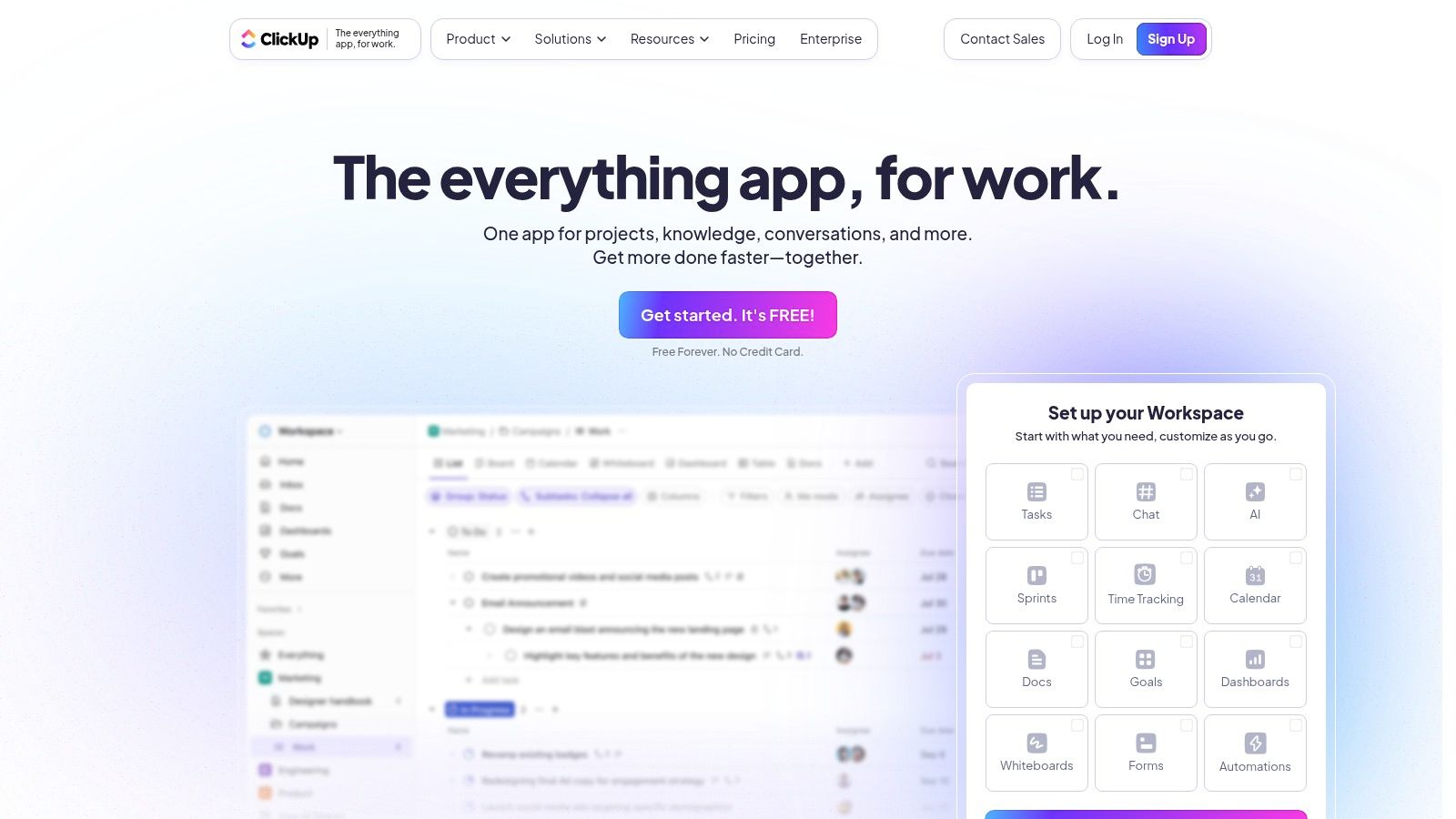
ClickUp's hierarchical structure, with Workspaces, Spaces, Folders, Lists, and Tasks, allows for granular organization and control over projects of any scale. This makes it particularly useful for project managers and team leads who need to manage complex projects with multiple moving parts. The platform also integrates seamlessly with other tools, offering 500+ native integrations and powerful automation capabilities. Features like built-in document creation, collaborative whiteboards, and goal tracking further enhance its value as a comprehensive workspace. For example, sales teams can manage their CRM directly within ClickUp, while marketing teams can plan campaigns and track progress using the platform's various views and integrations. Small and medium-sized businesses looking for a unified task and project management solution will appreciate ClickUp's versatility.
One of ClickUp's biggest strengths is its generous free tier, which provides a surprisingly robust feature set compared to competitors. This makes it an attractive option for individual professionals and freelancers who manage tasks within environments like Google Workspace. For larger teams, the paid plans offer competitive pricing and advanced features such as time tracking, workload management, and advanced reporting. You can learn more about ClickUp and how it compares to traditional Kanban tools.
Pros:
- Exceptional value: Robust free tier and competitive pricing for paid plans.
- Highly versatile: Replaces multiple tools with a single platform.
- Advanced features: Time tracking, estimation, and reporting tools.
- Regular updates: Responsive development team actively adds and improves features.
Cons:
- Overwhelming: The sheer number of features and customization options can be daunting for new users.
- Performance issues: Occasional slowdowns reported with very large projects.
- Mobile app limitations: Mobile functionality is not as comprehensive as the desktop experience.
- Learning curve: Requires some time investment to master due to feature density.
Implementation Tip: Start with a simple project and gradually explore ClickUp's features. Focus on mastering one view at a time before diving into the more advanced functionalities. This phased approach will prevent you from feeling overwhelmed and allow you to effectively leverage the platform's capabilities. Google Workspace administrators can also explore integrations to streamline workflows for their teams.
ClickUp earns its spot on this list as a powerful kanban alternative thanks to its extensive customization, diverse view options, and comprehensive feature set. While the sheer breadth of features might feel overwhelming initially, the platform's flexibility and generous free tier make it a worthwhile option for teams and individuals seeking a powerful, all-in-one productivity solution. It offers a significant upgrade from basic Kanban boards for those who require more robust features and integrations.
6. Notion
Notion is a powerful kanban alternative that goes beyond simple task management, offering a comprehensive workspace for notes, documents, databases, and project collaboration. While traditional Kanban tools focus solely on task boards, Notion provides a highly customizable environment where you can build knowledge bases, wikis, and various project views, including Kanban-style boards, all within a unified platform. This makes it an excellent choice for teams and individuals seeking a centralized hub for all their work.
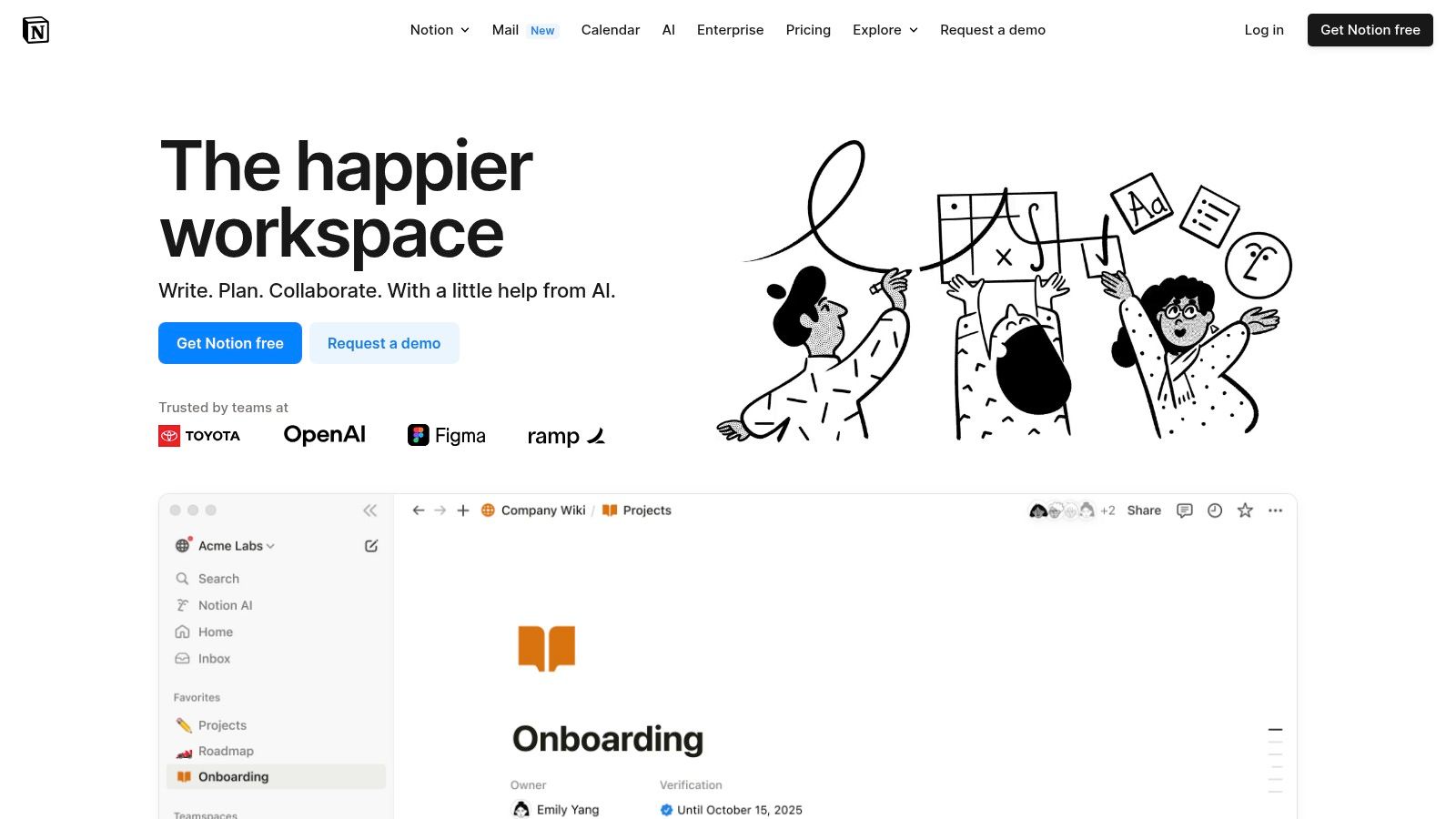
Notion's database functionality is its core strength. It allows you to visualize your data in multiple views, including Kanban boards, tables, lists, calendars, and galleries. This flexibility is a key differentiator, enabling you to adapt your workflow to different project needs and individual preferences. For example, a marketing team could use a Kanban board for content creation, a calendar for scheduling social media posts, and a table to track campaign performance, all within the same Notion workspace. Nested pages and subpages provide a structured way to organize information, creating a hierarchical system for your projects and documentation. This is especially beneficial for complex projects with multiple deliverables and subtasks. Rich text editing with markdown support and the ability to embed content from other platforms further enhance Notion's versatility, allowing for seamless documentation and collaboration.
For project managers and teams seeking a kanban alternative, Notion offers a compelling solution. Its customizable Kanban boards enable you to visualize workflows, track progress, and manage tasks effectively. Compared to dedicated Kanban tools like Trello, Notion offers greater flexibility by combining task management with other essential tools like note-taking and wikis. This unified approach can streamline workflows and reduce the need to switch between multiple applications. Small and medium-sized businesses can leverage Notion as a central hub for project management, documentation, and internal communication. Sales teams, for instance, can manage their sales pipeline within Notion, track customer interactions, and maintain a knowledge base of sales materials. Even individual professionals and freelancers can benefit from Notion's versatility, using it for personal task management, note-taking, and even building a personal website.
Notion offers a free tier that is suitable for individual users, while paid plans cater to teams and businesses with increased functionality and collaboration features. Specific pricing details can be found on their website. While there are no strict technical requirements, a stable internet connection is recommended for optimal performance. Notion works across various devices, including desktops, laptops, tablets, and smartphones.
Implementation Tips:
- Start with a template: Notion offers a wide range of templates for various use cases, from personal task management to company wikis. Leveraging these templates can significantly reduce setup time and provide a starting point for building your workspace.
- Define your workflow: Before diving into Notion, clearly outline your workflow and the specific needs of your team or project. This will help you structure your workspace effectively and utilize Notion's features to their full potential.
- Experiment with different views: Explore the various database views available in Notion to find the best fit for your project. The ability to switch between Kanban boards, tables, and other views provides a dynamic way to visualize and manage your data.
Pros:
- Exceptional flexibility to create custom workflows and systems
- Combines document management and project management in one tool
- Reasonable pricing with a usable free tier for individuals
- Strong community with many shared templates and integrations
Cons:
- Requires significant setup time to create optimal workflows
- Can be overwhelming for new users due to blank-slate approach
- Limited offline capabilities
- Lacks some advanced project management features like Gantt charts natively
Website: https://notion.so
7. Airtable: A Kanban Alternative for Data-Driven Teams
If your team needs more than just a simple Kanban board and thrives on robust data management, Airtable is a compelling kanban alternative. It's a cloud-based platform that combines the flexibility of a spreadsheet with the power of a relational database. Unlike traditional Kanban tools that primarily focus on task movement, Airtable allows you to connect related information across multiple tables, offering a more comprehensive view of your projects and data. This makes it ideal for teams who need to manage complex datasets alongside their project workflows.
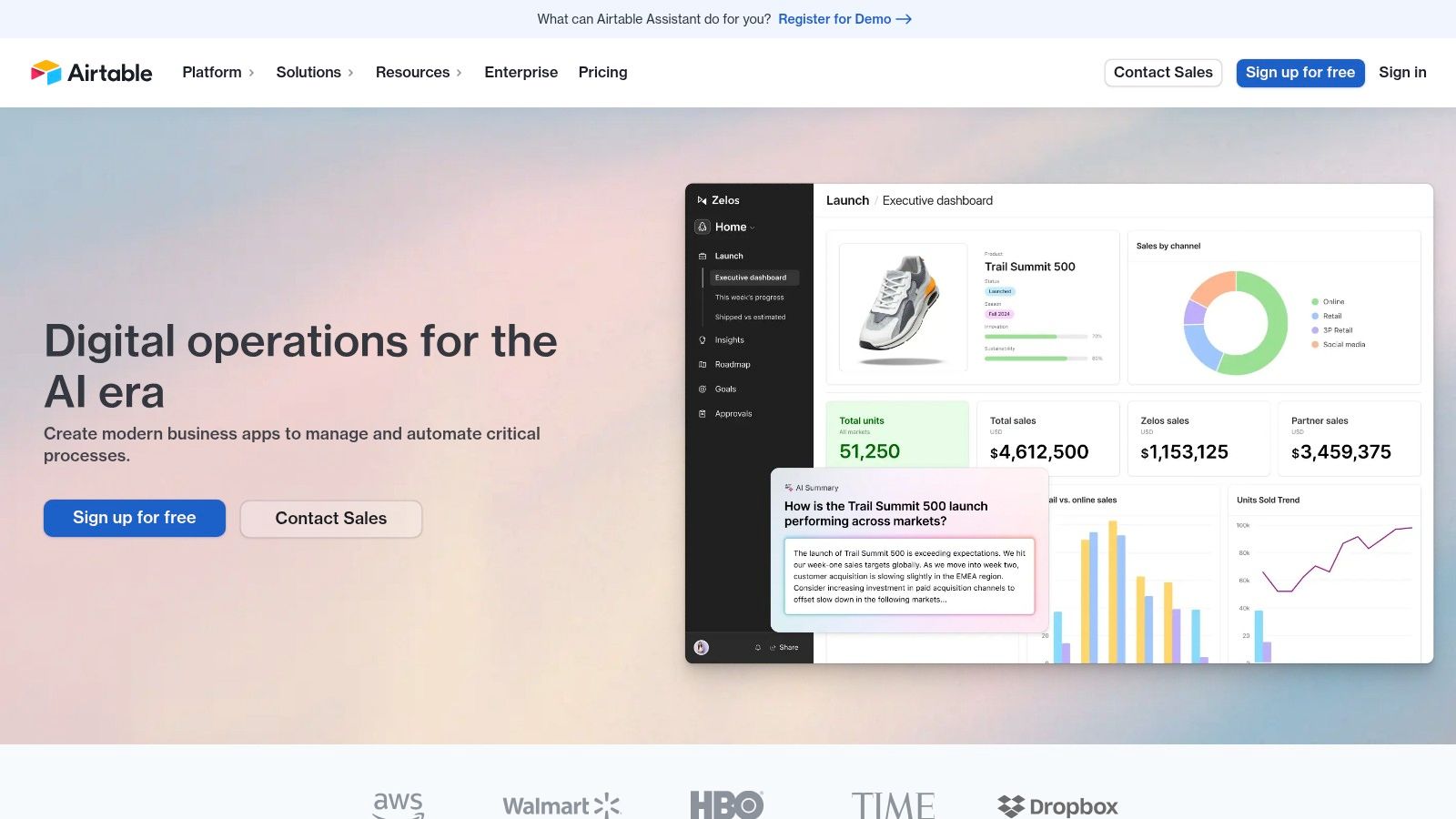
Airtable's strength lies in its versatility. You can visualize your data in various ways, including Kanban, grid, calendar, Gantt, form, and gallery views. This allows you to tailor the platform to fit your specific project management needs. For example, a marketing team could use a Kanban board to track content creation, a calendar view to schedule social media posts, and a grid view to manage their budget. This unified approach eliminates the need for multiple tools and keeps all information centralized and accessible.
Key Features and Benefits:
- Relational Database Structure: Link related information across different tables, creating a powerful data ecosystem. This is particularly useful for connecting tasks to clients, budgets, or other relevant data points.
- Multiple View Types: Switch between Kanban, grid, calendar, Gantt, form, and gallery views to visualize and manage data in the most effective way for each project.
- Rich Field Types: Leverage attachments, long text fields, checkboxes, formula fields, and more to capture all necessary information.
- Blocks Feature: Extend functionality with apps and integrations to further customize your workspace.
- Automations: Streamline workflows and reduce manual data entry by automating repetitive tasks.
Pros:
- Unmatched flexibility for data organization and relationship mapping: Airtable goes beyond basic task management to provide a comprehensive data management solution.
- Powerful filtering, grouping, and sorting capabilities: Easily analyze and manipulate data to gain valuable insights.
- Excellent for teams that need to manage complex datasets alongside projects: Ideal for situations where projects involve substantial data tracking and analysis.
- API access even in the free tier for custom integrations: Connect Airtable with other tools and services to create a seamless workflow.
Cons:
- Record limits in free and lower-tier plans can be restrictive: Depending on your data volume, you might need to upgrade to a paid plan.
- Not as intuitive for pure project management as dedicated tools: While offering Kanban, its focus on data management can add complexity for simple projects.
- Mobile experience is limited compared to desktop: While mobile apps exist, the full functionality is best experienced on a desktop.
- Can get expensive for larger teams or databases: Pricing scales with usage, so costs can increase significantly for large teams or extensive databases.
Pricing: Airtable offers a free plan, as well as paid plans starting at $10 per user per month. The paid plans offer increased record limits, storage, and collaboration features.
Technical Requirements: Airtable is a cloud-based platform accessible via a web browser or mobile app.
Implementation Tips:
- Start with a clear understanding of your data and how you want to organize it.
- Utilize templates to get started quickly with common use cases.
- Explore the different view types to find the best way to visualize your data.
- Leverage automations to streamline your workflows and reduce manual effort.
Airtable earns its place as a kanban alternative for teams who need a data-centric approach to project management. Its relational database structure and powerful features provide a level of flexibility and control that traditional Kanban boards simply can't match. If you're looking for a tool that can handle both your project tasks and the associated data, Airtable is definitely worth considering. Visit Airtable
8. Linear
If you're a software development team seeking a kanban alternative that prioritizes speed and a streamlined workflow, Linear is worth serious consideration. It's designed specifically for software development, offering a focused experience that goes beyond the capabilities of general-purpose Kanban boards. Linear emphasizes a fast and visually appealing interface tailored to the unique needs of technical teams. This makes it a strong contender for those tired of adapting generic project management tools to fit their software development processes.
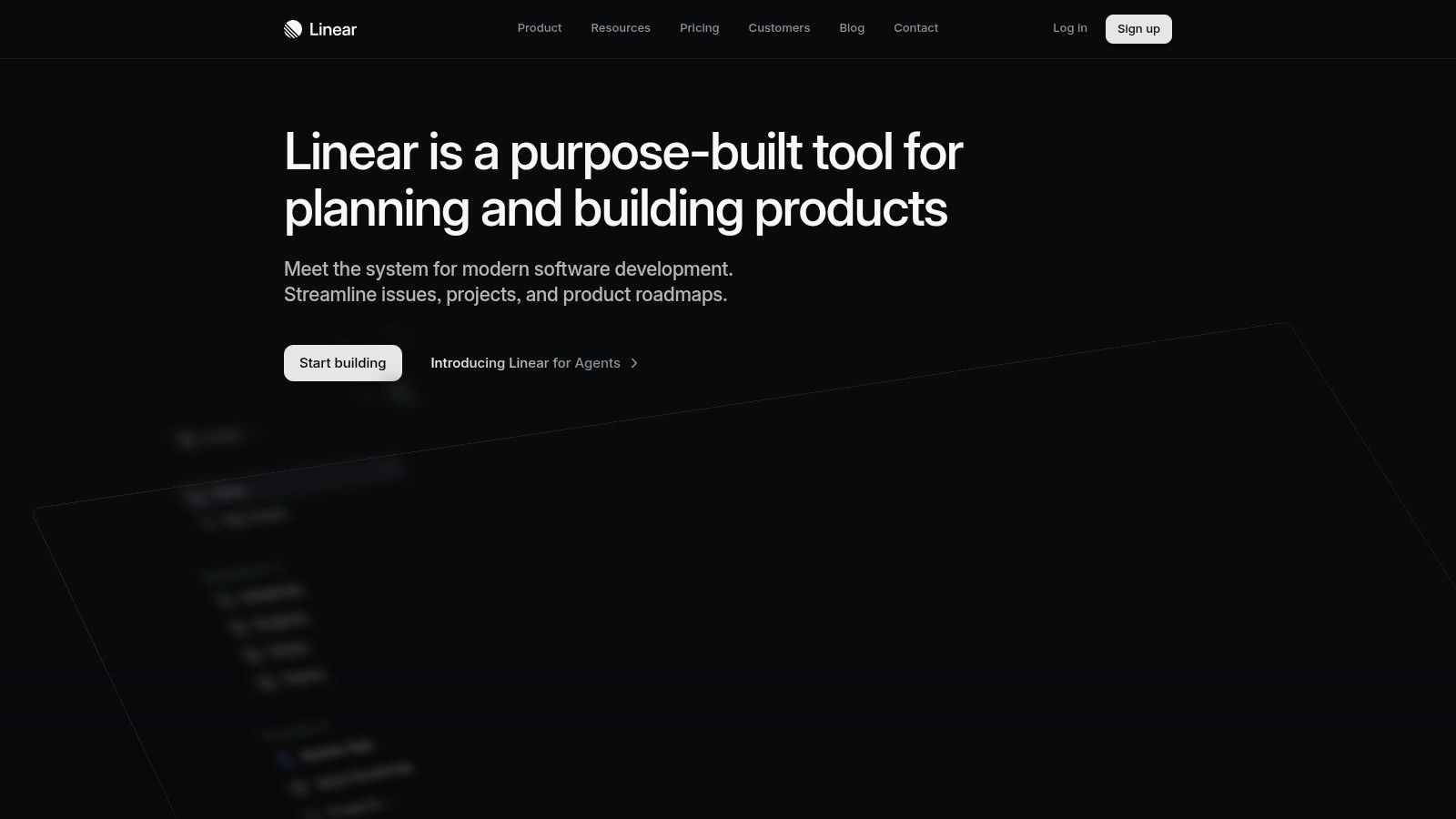
Linear provides features like project milestones and roadmap planning specifically designed for software development cycles. Its powerful command palette (cmd+k) and extensive keyboard shortcuts allow for efficient navigation and task management, minimizing clicks and context switching. Tight integration with Git automatically updates issues based on pull requests and commits, keeping your team informed of code changes without manual intervention. The Linear Method, a built-in workflow suggestion, promotes effective team collaboration by providing a structured approach to project execution. For further customization and automation, Linear offers a GraphQL API.
While Linear excels in its focus on software development, this specialization also presents some limitations. It may not be the best fit for non-technical teams or those needing a wider range of integrations with other business tools. Compared to more established project management platforms, Linear's customization options and integrations are somewhat limited. The pricing structure, starting with a free trial and then moving to a paid subscription, might also be a barrier for smaller teams or individuals. There is no permanent free tier.
Key Features and Benefits:
- Speed and Responsiveness: Linear is built for speed, with a minimal and responsive interface that reduces loading times and keeps your workflow moving.
- Software Development Focus: Features like Git integration, keyboard shortcuts, and a streamlined UI cater specifically to the needs of software teams.
- Intuitive Design: The minimalist design reduces cognitive load and makes it easy to navigate and manage tasks.
- Powerful Command Palette: Quickly access any feature or task with the cmd+k command palette.
- Linear Method: A structured workflow suggestion promotes efficient team collaboration.
Pros:
- Exceptionally fast and responsive interface
- Purpose-built for software teams
- Beautiful, minimalist design
- Strong focus on keyboard shortcuts
Cons:
- Less suitable for non-technical teams
- Fewer integrations compared to other tools
- Less customizable than general-purpose tools
- Higher starting price point, no free tier
Website: https://linear.app
Implementation Tips:
- Leverage the Linear Method to establish a structured workflow for your team.
- Utilize keyboard shortcuts to maximize efficiency.
- Integrate Linear with your Git repository for seamless code-to-issue tracking.
Linear earns its place on this list as a high-performance kanban alternative specifically tailored for software development. If speed, a clean interface, and a developer-centric workflow are your priorities, Linear is well worth exploring. However, consider its limitations regarding integrations, customization, and pricing before committing.
Kanban Alternatives Feature Comparison
| Product | Core Features ✨ | User Experience ★ | Value Proposition 💰 | Target Audience 👥 | Unique Selling Points 🏆 |
|---|---|---|---|---|---|
| Tooling Studio 🏆 | Native Gmail & Google Tasks integration, Kanban boards, drag-and-drop, Sales CRM (beta) | ★★★★☆ Clean UI, seamless Google Workspace fit | 💰 Free Kanban Tasks, premium soon | 👥 SMBs, freelancers, project managers, sales teams | ✨ Unified Google Workspace ecosystem, real-time collaboration, continuous updates |
| Trello | Boards, lists, cards, Power-Ups, automation | ★★★★☆ Intuitive, easy to adopt | 💰 Robust free tier, paid advanced | 👥 Small to medium teams, general projects | ✨ Extensive integrations, simple visual task management |
| Asana | Multiple views (list, board, timeline), custom workflows | ★★★★☆ Versatile, robust task mgmt | 💰 Free basic, pricey enterprise | 👥 Cross-functional teams, project managers | ✨ Advanced reporting, goal tracking, workload view |
| Monday.com | Highly customizable boards, automations, templates | ★★★★☆ Engaging, colorful UI | 💰 Can be expensive for scaling | 👥 Small to enterprise organizations | ✨ 30+ column types, 200+ templates, rich visual customization |
| ClickUp | 15+ views, docs, goals, whiteboards, automation | ★★★★☆ Feature-rich but complex | 💰 Generous free plan, competitively priced | 👥 Versatile teams needing all-in-one platform | ✨ All-in-one productivity suite, 500+ integrations |
| Notion | Notes, docs, databases, multiple views | ★★★★☆ Flexible but setup-heavy | 💰 Reasonable price, free tier for individuals | 👥 Individuals, startups, knowledge workers | ✨ Rich customization, combined doc & project mgmt |
| Airtable | Relational DB, multiple views, automations | ★★★★☆ Powerful but less intuitive | 💰 Free tier limits, pricier large teams | 👥 Teams managing complex data & projects | ✨ Spreadsheet + DB hybrid, API access in free tier |
| Linear | Issue tracking, roadmap, GitHub integration | ★★★★☆ Fast, minimalist UI | 💰 No free tier, premium pricing | 👥 Software development teams | ✨ Keyboard shortcuts, dev-focused workflows |
Choosing the Right Kanban Alternative for Your Needs
Finding the perfect project management tool can feel overwhelming. This list of kanban alternatives—from established platforms like Trello and Asana to powerful up-and-comers like Linear and Tooling Studio—offers a variety of solutions for teams of all sizes and project scopes. Remember that the “best” tool depends entirely on your specific needs. Consider factors like team size, project complexity, budget, and necessary integrations with existing platforms like Google Workspace when making your decision.
Some key takeaways to remember as you evaluate these kanban alternatives include the importance of user-friendliness for quick adoption, the power of integrations to streamline your workflow, and the scalability of the platform to accommodate growth. Gathering and analyzing feedback is crucial for selecting the right tool. Understanding the product feedback loop from Saylo can significantly improve your decision-making process and ultimately lead to a more successful tool implementation.
Choosing and implementing a new tool requires careful planning. Start by clearly defining your team’s requirements and pain points with your current process. Then, prioritize the features that address these challenges. Don't hesitate to leverage free trials and demos to explore the functionalities of each kanban alternative firsthand. This hands-on experience will provide valuable insights into whether a platform truly aligns with your team’s working style and project management needs.
Finding the right tool empowers your team to collaborate effectively, manage projects efficiently, and ultimately achieve your goals. For teams deeply embedded in the Google Workspace ecosystem and looking for a powerful, streamlined kanban alternative, consider exploring Tooling Studio. Its seamless integration with Google Workspace allows you to manage tasks and projects without ever leaving your familiar environment. Give Tooling Studio a try and experience a new level of productivity within Google Workspace.